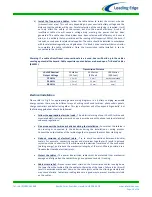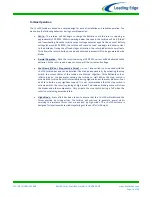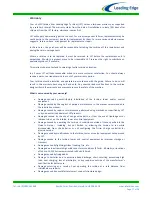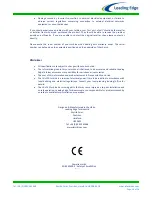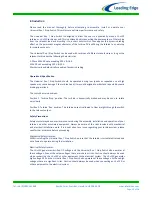
Tel: +44 (0)1981 241668
Skyrrid Farm, Pontrilas, Hereford. HR2 0BW. UK
www.leturbines.com
Page 22 of 28
Electrical Installation
Please refer to electrical schematic for appropriate generic wiring diagrams. In a battery charging
renewable energy system, there may be different ways of wiring small wind turbines, photovoltaic
panels, charge controllers and batteries together. This type of system will often expand
‘organically’, but the following guidelines should be followed:
Location – The DL-300 controller should be mounted in an adequately ventilated area, which is not
exposed to direct moisture or spray. The dump load elements become hot during normal operation
and should not be covered or blocked. Ideally allow 75mm of free space around the unit.
Flooded and Gel Batteries – An electrical jumper needs to be added to make the controller more
suitable for use with 'Flooded' batteries. A jumper (supplied) should be applied to pins labelled
'2.2'. When the DL-300 is to be used with Gel batteries, no jumper should be applied to pins '2.2'.
Under no circumstances, should a jumper be applied to pins '2.1' (position shown to help locate
pins 2.2).
Jumper Pins 2.1
Jumper Pins 2.2
Gel type Batteries
No Jumper
No Jumper
Flooded type Batteries
No Jumper
Connect Jumper
Use the correct voltage controller – A 12V DL-300 controller should only be used on a 12V battery
system. A 24V DL300 controller should only be used on a 24V battery system. Do not interchange.
Follow the appropriate electrical code - The electrical wiring of your LE-v150 turbine and
associated electrical systems must be done in accordance with national and local electrical codes
and regulations.
Do not connect the turbine or batteries during the installation - Ensure that the turbine is not
running or connected to the batteries during the installation or wiring process. Connect the output
cables of the turbine together to prevent the rotor from starting up.
Galvanic corrosion of electrical joints - Try to avoid connections between dissimilar metals. For
example, connecting copper and aluminium together will result in galvanic corrosion of the
connection. This will increase the electrical resistance of the connection (wasting energy), and
reduce the mechanical integrity of the joint. Where possible, use a fluxed solder to make electrical
joints.



